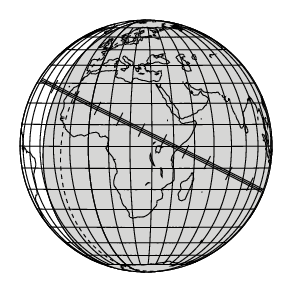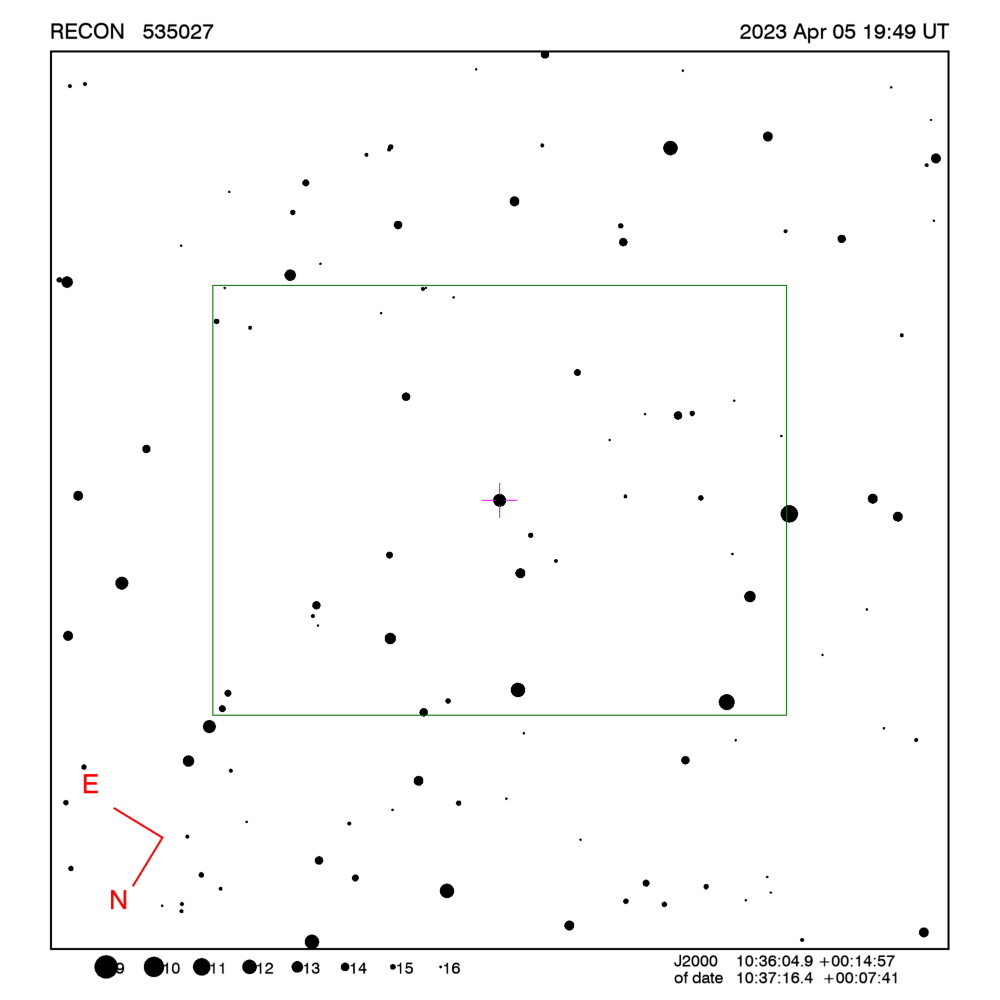RECON: TNO occultation with 535027
Event between (535027) 14WY509 and star GA0900:03686527
with event index number of 2337737
Geocentric closest approach at 2023/04/05 19:51:31 UTC
J2000 position of star is 10:36:04.9 +00:14:57
Equinox of date position of star is 10:37:13.4 +00:08:00
Stellar brightness G=13.0,
use SENSEUP=32 with the MallinCam and and exposure
time of 500 milli-seconds with the QHY174 camera.
Star is 33 degrees from the moon.
Moon is 100% illuminated.
TNO apparent brightness V=22.3
 TNO is 43.1 AU from the Sun
and 42.2 AU from the Earth.
TNO is 43.1 AU from the Sun
and 42.2 AU from the Earth.
The TNO is moving 20.3
km/sec on the sky relative to the star, or,
2.4 arcsec/hr.
The 1-sigma error in the time of the event is 111 seconds.
The 1-sigma cross-track error in the shadow position is
1980 km.
The TNO has an absolute magnitude Hv=5.9
Diameter=400.0 km assuming a 5% albedo -- 20.0 sec chord
Diameter=163.3 km assuming a 30% albedo -- 8.2 sec chord
Dynamical classification is SCATEXTD
Star training set for 535027, (2023/04/05 19:49UT)
Object RA Dec mag sep mel
Regulus 10:09:36.5 +11:51:09 1.3 13.59 42
30Bet Sex 10:31:28.8 -00:45:25 4.8 1.70 34
PPM 178248 10:41:12.8 -00:16:08 8.4 1.06 31
PPM 156982 10:36:20.4 +00:14:55 10.0 0.26 33
535027 10:37:16.4 +00:07:41 13.0 32
Positions are for equinox of date

Azimuth is measured in degrees eastward from north.
North is at an azimuth of 0, due East is at an azimuth
of 90 degrees, due South is 180, and due West is 270.
Do not use the listing below for the RECON CPC 1100 telescopes.
This is provided for other non-team facilities.
Star training set for 535027, (2023/04/05 19:49UT)
Object RA Dec mag sep mel
Regulus 10:08:21.9 +11:58:02 1.3 13.59 42
30Bet Sex 10:30:17.4 -00:38:14 4.8 1.70 34
PPM 178248 10:40:01.3 -00:08:49 8.4 1.06 31
PPM 156982 10:35:08.8 +00:22:11 10.0 0.26 33
535027 10:36:04.9 +00:14:57 13.0 32
Positions are for J2000
Event circumstances last updated at 2022/04/16 00:18:52 UT
Marc W. Buie,
Southwest Research Institute
RECON
 TNO is 43.1 AU from the Sun
and 42.2 AU from the Earth.
TNO is 43.1 AU from the Sun
and 42.2 AU from the Earth.
